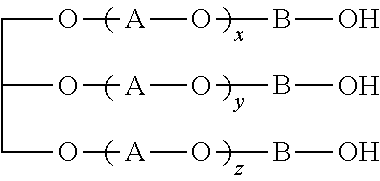Flexible polyurethane foam and method of producing same
a polyurethane foam and flexible technology, applied in the field can solve the problems of flex fatigue, cellular structure compromise of flexible polyurethane foam, etc., and achieve the effect of reducing costs and processing steps, excellent comfort and support properties
- Summary
- Abstract
- Description
- Claims
- Application Information
AI Technical Summary
Benefits of technology
Problems solved by technology
Method used
Image
Examples
examples
[0047]A flexible polyurethane foam comprises the reaction product of an isocyanate component and an isocyanate-reactive component. The isocyanate component and the isocyanate-reactive component are separately formed. Each respective composition for the isocyanate component and the isocyanate-reactive component is exemplified below.
[0048]Isocyanate-Reactive Components 1-5:
[0049]The amount and type of each component used to form each isocyanate-reactive component is indicated in Table 1 below with all values in parts by weight based on 100 parts by weight of total polyol present in each isocyanate-reactive component, i.e., the parts by weight for each component are not normalized to 100 parts of the total weight of the isocyanate-reactive component.
TABLE 1Isocyante-Isocyante-Isocyante-Isocyante-Isocyante-reactivereactivereactivereactivereactiveComponentComponent 1Component 2Component 3Component 4Component 5Polyether Polyol100.00100.00100.00100.00100.00Catalyst 10.360.360.300.360.40Cat...
PUM
| Property | Measurement | Unit |
|---|---|---|
| density | aaaaa | aaaaa |
| temperature | aaaaa | aaaaa |
| temperature | aaaaa | aaaaa |
Abstract
Description
Claims
Application Information
 Login to View More
Login to View More - R&D
- Intellectual Property
- Life Sciences
- Materials
- Tech Scout
- Unparalleled Data Quality
- Higher Quality Content
- 60% Fewer Hallucinations
Browse by: Latest US Patents, China's latest patents, Technical Efficacy Thesaurus, Application Domain, Technology Topic, Popular Technical Reports.
© 2025 PatSnap. All rights reserved.Legal|Privacy policy|Modern Slavery Act Transparency Statement|Sitemap|About US| Contact US: help@patsnap.com



